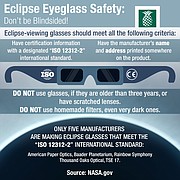NEVER look at the sun directly ‑ your mom may have told you more than once.
And she was right. This is also true during the long-anticipated total or partial solar eclipse that will take place Monday, August 21.
Anyone within the “path of totality” will see a total solar eclipse. This path is where the moon will completely block the sun. Many individuals should experience a partial solar eclipse — that’s about a 75 per cent effect. The last contiguous eclipse, meaning that it was visible across the United States, was February 26, 1979. After August 21, this type of event won’t happen again until October 14, 2023, according to the National Aeronautics and Space Administration (NASA).
In the Bahamas, the partial solar eclipse will begin at about 1.30pm and end about three hours later. The maximum eclipse should be visible around 3.05pm.
NASA has stressed that it’s “never safe to look directly at the sun’s rays – even if the sun is partly obscured.”
NASA recommends the use of solar filter eclipse glasses or pin-hole projectors if you wish to watch the partial eclipse. The American Astronomical Society offers a list of reputable vendors of solar filters and viewers.
“When watching a partial eclipse you must wear eclipse glasses at all times if you want to face the sun, or use an alternate indirect method,” NASA recommends on its website. “This also applies during a total eclipse up until the time when the sun is completely and totally blocked.
“During the short time when the moon completely obscures the sun – known as the period of totality – it is safe to look directly at the star, but it’s crucial that you know when to take off and put back on your glasses.”
An eclipse is a rare event, but protecting your eyes from the sun should be a daily occurrence, said Dr Keith Skolnick, an ophthalmologist with the Baptist Eye Surgery Centre in Florida.
Solar retinopathy refers to eye damage which has been caused by looking directly at the sun, at any time or during an eclipse. The retina is made up of delicate tissue that is sensitive to light. Harmful radiation from the sun can reach the eye and damage the retina. This burns the retina and destroys the cells that enable you to see. The retina’s cells are sensitive to light, which helps form visual images via the optic nerve.
“With the eclipse, if you look directly at the sun that can lead to permanent damage of the macular, the centre and most important part of the retina,” explained Dr Skolnick. “It’s basically a sunburn of the macula.”
Baptist Health South Florida said people should always protect their eyes from the sun’s ultraviolet (UV) radiation, which is also a major risk for skin cancers. Sunlight is the main source of UV rays, which is why ophthalmologists urge all patients to wear sunglasses with UV protection when outside, the group noted.
Sunlight reflected off sand and water can cause photokeratitis, the condition responsible for snow blindness, so beach and pool-goers should exercise caution by wearing sunglasses with UV protection.
“I tell my patients that the colour of sunglasses doesn’t matter, nor does how dark the lens is,” said Dr Skolnick. “The important thing is for your glasses to have UV radiation protection. And cost shouldn’t be a factor. You don’t have to spend a lot of money for glasses that protect your eyes.”




Comments
Use the comment form below to begin a discussion about this content.
Sign in to comment
Or login with:
OpenID